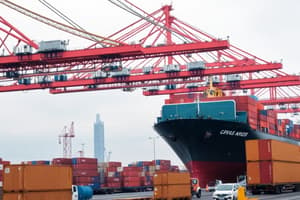Podcast
Questions and Answers
Which of the following is a primary challenge associated with offshoring that can significantly impact costs?
Which of the following is a primary challenge associated with offshoring that can significantly impact costs?
- Simplified information flow
- Reduced risk in supply chain management
- Increased risk (correct)
- Decreased supply chain length
Offshoring always results in lower raw material costs due to access to cheaper resources.
Offshoring always results in lower raw material costs due to access to cheaper resources.
False (B)
How does increased supply lead time due to offshoring affect forecasting and inventory levels?
How does increased supply lead time due to offshoring affect forecasting and inventory levels?
poorer forecasts and higher inventories
A global supply chain with offshoring increases the length and duration of information, product, and ______ flows.
A global supply chain with offshoring increases the length and duration of information, product, and ______ flows.
Match the performance dimension with the potential impact of offshoring:
Match the performance dimension with the potential impact of offshoring:
What is a primary opportunity presented by globalization in the context of supply chain networks?
What is a primary opportunity presented by globalization in the context of supply chain networks?
Focusing exclusively on unit cost, rather than total cost, typically leads to successful offshoring ventures.
Focusing exclusively on unit cost, rather than total cost, typically leads to successful offshoring ventures.
According to the Accenture survey, which risk factor affects the highest percentage of global supply chains?
According to the Accenture survey, which risk factor affects the highest percentage of global supply chains?
The uncertainty of demand and price in global supply chains increases the value of building __________ production capacity.
The uncertainty of demand and price in global supply chains increases the value of building __________ production capacity.
Match the following risk factors with their potential impact on global supply chains:
Match the following risk factors with their potential impact on global supply chains:
What is a significant challenge that accompanies the opportunities presented by globalization in supply chain networks?
What is a significant challenge that accompanies the opportunities presented by globalization in supply chain networks?
Incorporating suitable risk mitigation into supply chain design is often the difference between success and failure in globalized supply chains.
Incorporating suitable risk mitigation into supply chain design is often the difference between success and failure in globalized supply chains.
According to the Accenture Survey, which of the following risk factors affects approximately one-quarter of global supply chains?
According to the Accenture Survey, which of the following risk factors affects approximately one-quarter of global supply chains?
Which activity, when offshored, leads to poorer on-time delivery and increased uncertainty?
Which activity, when offshored, leads to poorer on-time delivery and increased uncertainty?
Offshoring invariably reduces product returns due to stringent quality control processes.
Offshoring invariably reduces product returns due to stringent quality control processes.
Name three key elements that constitute the total cost in global sourcing.
Name three key elements that constitute the total cost in global sourcing.
Larger minimum order quantities typically lead to an increase in _______.
Larger minimum order quantities typically lead to an increase in _______.
Match the risk with its potential impact on a global supply chain.
Match the risk with its potential impact on a global supply chain.
Which of the following can be a hidden cost associated with offshoring?
Which of the following can be a hidden cost associated with offshoring?
Stockouts are likely to decrease when ordering, production, and transportation visibility is poor.
Stockouts are likely to decrease when ordering, production, and transportation visibility is poor.
Besides supply and demand fluctuations, list two other critical risks that global supply chains must manage.
Besides supply and demand fluctuations, list two other critical risks that global supply chains must manage.
Which of the following is NOT a key area of uncertainty that executives must consider, according to the text?
Which of the following is NOT a key area of uncertainty that executives must consider, according to the text?
Discounted cash flow (DCF) analysis evaluates the future value of cash flows.
Discounted cash flow (DCF) analysis evaluates the future value of cash flows.
What economic principle underlies the concept of discounted cash flow?
What economic principle underlies the concept of discounted cash flow?
A decision tree is a ______ device used to evaluate decisions under uncertainty.
A decision tree is a ______ device used to evaluate decisions under uncertainty.
In decision tree analysis, what is the significance of 'T'?
In decision tree analysis, what is the significance of 'T'?
When using decision tree methodology, in which period do you begin the process of identifying the optimal decision and expected cash flows?
When using decision tree methodology, in which period do you begin the process of identifying the optimal decision and expected cash flows?
Match each step of the decision tree methodology with its description:
Match each step of the decision tree methodology with its description:
Supply chain decisions should be evaluated as a single cash flow.
Supply chain decisions should be evaluated as a single cash flow.
Which of the following is NOT a direct method for mitigating supply chain risk through network design?
Which of the following is NOT a direct method for mitigating supply chain risk through network design?
Increasing decentralization as cost of capacity increases is a recommended risk mitigation strategy when focusing on low-cost capacity for predictable demand.
Increasing decentralization as cost of capacity increases is a recommended risk mitigation strategy when focusing on low-cost capacity for predictable demand.
For short life-cycle products, should a supply chain favor cost or responsiveness as a risk mitigation strategy?
For short life-cycle products, should a supply chain favor cost or responsiveness as a risk mitigation strategy?
To mitigate risk for predictable, lower-value products, companies should ___________ inventory.
To mitigate risk for predictable, lower-value products, companies should ___________ inventory.
Match the risk mitigation strategy with the appropriate tailored strategy for unpredictable demand:
Match the risk mitigation strategy with the appropriate tailored strategy for unpredictable demand:
For high-value, high-risk products, what sourcing strategy is generally preferred?
For high-value, high-risk products, what sourcing strategy is generally preferred?
When is it most beneficial to centralize redundancy for low-volume products?
When is it most beneficial to centralize redundancy for low-volume products?
New product flexibility refers to the ability to rapidly change the volume of production in response to demand fluctuations.
New product flexibility refers to the ability to rapidly change the volume of production in response to demand fluctuations.
According to the material, focusing on cost over flexibility is always the superior strategy for high-volume products, regardless of predictability.
According to the material, focusing on cost over flexibility is always the superior strategy for high-volume products, regardless of predictability.
What should global supply chains use to manage uncovered risks?
What should global supply chains use to manage uncovered risks?
What type of flexibility refers to the ability of a company to produce a variety of products within a short timeframe?
What type of flexibility refers to the ability of a company to produce a variety of products within a short timeframe?
The marginal benefit derived from increased flexibility typically ______ as flexibility is increased.
The marginal benefit derived from increased flexibility typically ______ as flexibility is increased.
What is a potential drawback of long supply chains designed to pool available capacity?
What is a potential drawback of long supply chains designed to pool available capacity?
Flexibility and chaining strategies are highly effective in mitigating the impact of supply disruptions.
Flexibility and chaining strategies are highly effective in mitigating the impact of supply disruptions.
Which of the following is a decision that can be evaluated using decision trees in supply chain management?
Which of the following is a decision that can be evaluated using decision trees in supply chain management?
When deciding on transportation capacity, firms must determine the right mix between what two options?
When deciding on transportation capacity, firms must determine the right mix between what two options?
Flashcards
Offshoring
Offshoring
Relocating business processes to another country to reduce costs.
Total Cost Evaluation
Total Cost Evaluation
Assessing all costs related to offshoring, including hidden ones.
Supply Chain Visibility
Supply Chain Visibility
The ability to track and monitor all stages of the supply chain.
Impact of Freight Costs
Impact of Freight Costs
Signup and view all the flashcards
Lead Time
Lead Time
Signup and view all the flashcards
Globalization Impact
Globalization Impact
Signup and view all the flashcards
Risk Mitigation
Risk Mitigation
Signup and view all the flashcards
Flexible Production Capacity
Flexible Production Capacity
Signup and view all the flashcards
Natural Disasters Risk
Natural Disasters Risk
Signup and view all the flashcards
Volatility of Fuel Prices
Volatility of Fuel Prices
Signup and view all the flashcards
Currency Fluctuation Risk
Currency Fluctuation Risk
Signup and view all the flashcards
Total Cost Focus
Total Cost Focus
Signup and view all the flashcards
Reasons Offshoring Fails
Reasons Offshoring Fails
Signup and view all the flashcards
Network Design Impact
Network Design Impact
Signup and view all the flashcards
Mitigation Strategy Costs
Mitigation Strategy Costs
Signup and view all the flashcards
Combination Strategies
Combination Strategies
Signup and view all the flashcards
Decentralized Capacity
Decentralized Capacity
Signup and view all the flashcards
Centralized Capacity
Centralized Capacity
Signup and view all the flashcards
Redundant Suppliers
Redundant Suppliers
Signup and view all the flashcards
Flexibility in Inventory
Flexibility in Inventory
Signup and view all the flashcards
Demand Aggregation
Demand Aggregation
Signup and view all the flashcards
Impact of Offshoring
Impact of Offshoring
Signup and view all the flashcards
Minimum Order Quantity
Minimum Order Quantity
Signup and view all the flashcards
Product Returns
Product Returns
Signup and view all the flashcards
Inventories and Lead Times
Inventories and Lead Times
Signup and view all the flashcards
Working Capital
Working Capital
Signup and view all the flashcards
Hidden Costs
Hidden Costs
Signup and view all the flashcards
Stockouts
Stockouts
Signup and view all the flashcards
Risk Management in Supply Chains
Risk Management in Supply Chains
Signup and view all the flashcards
Source Capability
Source Capability
Signup and view all the flashcards
Flexibility Types
Flexibility Types
Signup and view all the flashcards
New Product Flexibility
New Product Flexibility
Signup and view all the flashcards
Mix Flexibility
Mix Flexibility
Signup and view all the flashcards
Volume Flexibility
Volume Flexibility
Signup and view all the flashcards
Marginal Benefit of Flexibility
Marginal Benefit of Flexibility
Signup and view all the flashcards
Long Chains in Supply
Long Chains in Supply
Signup and view all the flashcards
Decision Trees in Operations
Decision Trees in Operations
Signup and view all the flashcards
Decision Tree
Decision Tree
Signup and view all the flashcards
Discounted Cash Flow (DCF)
Discounted Cash Flow (DCF)
Signup and view all the flashcards
Factors in Decision Trees
Factors in Decision Trees
Signup and view all the flashcards
Transition Probabilities
Transition Probabilities
Signup and view all the flashcards
Periodic Discount Rate
Periodic Discount Rate
Signup and view all the flashcards
Optimal Decision
Optimal Decision
Signup and view all the flashcards
Time Value of Money
Time Value of Money
Signup and view all the flashcards
Evaluating Supply Chain Decisions
Evaluating Supply Chain Decisions
Signup and view all the flashcards
Study Notes
Supply Chain Management: Strategy, Planning, and Operation - Chapter 6
- Designing Global Supply Chain Networks is the topic of Chapter 6.
- Globalization introduces opportunities for increased revenue and decreased costs.
- Significant risks and uncertainty accompany these opportunities.
Impact of Globalization on Supply Chain Networks
- Success often hinges on integrating risk mitigation into supply chain design.
- Demand and price uncertainty drive the need for flexible production capacity.
Impact of Globalization on Supply Chain Networks (Table 6-1)
- This table summarizes an Accenture survey on risks affecting global supply chains.
- Key risk factors include natural disasters, shortages of skilled resources, geopolitical uncertainty, terrorist infiltration, volatility of fuel prices, currency fluctuations, port operations delays, customer preference shifts, and performance of partners, logistics capacity and complexity, forecasting/planning accuracy, supplier communication, and inflexible technology.
- The survey quantifies these risks in terms of the percentage of supply chains affected by each risk factor. (Specific percentages are included in the table.)
Importance of Total Cost
- Comparative advantage in global supply chains is crucial.
- Offshore production benefits must be quantified along with reasons for offshoring.
- Key reasons why offshoring fails:
- Focusing too narrowly on unit cost instead of total cost.
- Ignoring critical risk factors.
The Offshoring Decision: Total Cost
- A global supply chain with offshoring increases the length and duration of information, product, and cash flows.
- Managing a global supply chain may present a significantly higher cost than initially anticipated.
- Factors contributing to total cost and are important to quantify and track over time.
Importance of Total Cost (Table 6-2)
- This table outlines dimensions to consider regarding the total cost of offshoring.
- Performance dimensions are presented, accompanied by related activities impacting performance and the impact of offshoring on these dimensions.
- Performance dimensions include order communication, supply chain visibility, raw material costs, unit cost, freight cost, taxes and tariffs, supply lead time, On-time delivery/lead time, minimum order quantity, product returns, inventories, working capital, hidden costs, and stockouts.
Importance of Total Cost (Table 6-2 Continued)
-
The table continues to expand on the dimensions for evaluating the total cost of offshoring.
-
Activities affecting performance and impacts of offshoring for each category listed are provided.
Importance of Total Cost (Key Elements)
- Key elements of total cost encompass supplier pricing, terms, delivery costs, inventory and warehousing, cost of quality, customer duties/taxes, cost of risk/procurement/brokerage, infrastructure, and tooling/mold costs.
- Exchange rate trends and their effect on overall cost are also relevant.
Risk Management in Global Supply Chains
- Global supply chain risks include supply disruption, delays, demand fluctuations, price fluctuations, and exchange-rate fluctuations.
- It's critical to identify risks and develop mitigation strategies.
Risk Management in Global Supply Chains (Table 6-3)
- This table identifies significant supply chain risks to consider when designing a global supply chain.
- Risks are categorized into disruptions, delays, systematic risk, and forecast risk.
- For each risk category, specific potential drivers are provided.
Risk Management in Global Supply Chains (Table 6-3 Continued)
- Continuing the categorization of Table 6-3, the table extends to risks related to intellectual property, procurement, receivables, inventory, and capacity.
Risk Management Strategies
- Good network design plays a critical role in mitigating risk.
- Mitigation strategies come with a price but can enhance overall risk management.
- Global supply chains benefit from combining rigorously evaluated mitigation strategies with financial strategies designed to hedge against uncovered risks.
Risk Management in Global Supply Chains (Table 6-4)
- A table that provides tailored risk mitigation strategies.
- Specific strategies cover increasing capacity, redundant suppliers and increasing responsiveness, as well as considerations associated with appropriate tailoring based on factors like cost vs flexibility and volume vs flexibility.
Flexibility, Chaining, and Containment
- Three major flexibility categories exist:
- New product flexibility
- Mix flexibility
- Volume flexibility
- Flexibility configurations for supply chains include dedicated networks, fully flexible networks, and chained networks.
- Longer supply chains provide greater aggregate capacity for managing demand uncertainty but can have higher fixed costs and also more complex coordination.
Using Decision Trees
- Decision trees are used to assess decisions.
- Executives use decision trees to estimate global currency instability, unpredictable commodity costs, uncertainties about customer demand, political/social unrest, and changes in government regulations affecting demand/price forecasts.
Discounted Cash Flows
- Supply chain decisions are evaluated by considering a time-based sequence of cash flows.
- Discounted cash flow (DCF) analysis calculates the present value of future cash flows, allowing managers to weigh different options concerning the financial value.
- Cash flow values are based on the time value of money—a dollar today is worth more than a dollar in the future.
Basics of Decision Tree Analysis
- A decision tree visually represents how a firm should assess decisions under conditions that introduce uncertainty.
- The analysis method incorporates a defined timeframe and identifying factors predicted to fluctuate or vary over this timeframe.
- The analysis then uses the tree methodology to evaluate the decision.
Decision Tree Methodology (Specific Steps)
- Key steps in applying decision tree methodology include:
- Defining evaluation period timeframe
- Identifying factors that introduce uncertainty
- Defining uncertainty levels for these factors
- Identifying discount rates
- Visualizing the decision tree with specified states/probabilities
- Working backward through the decision tree to determine optimal decisions and expected cash flows at each stage.
Studying That Suits You
Use AI to generate personalized quizzes and flashcards to suit your learning preferences.




